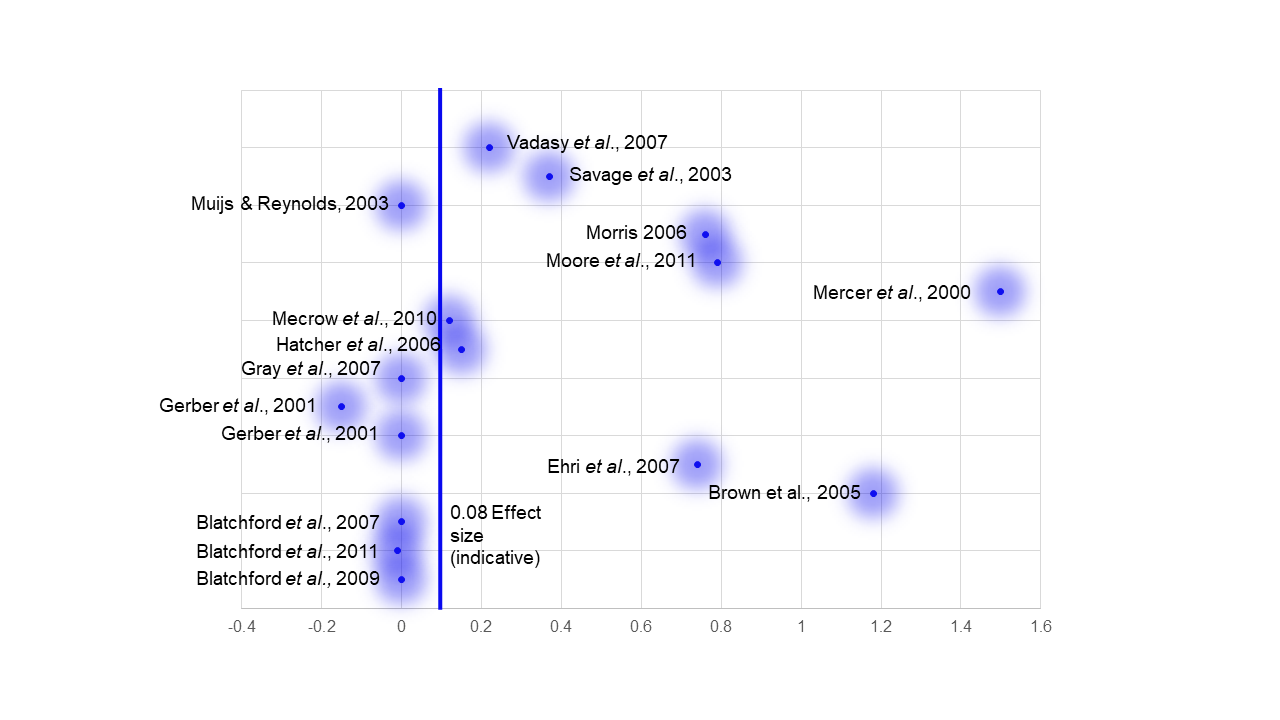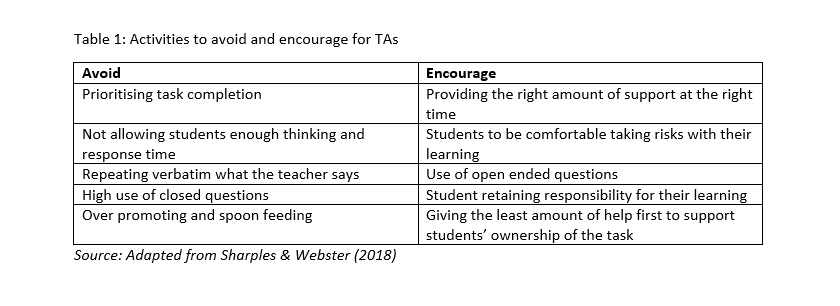Teaching assistants are important resources and when utilised in an evidence-based manner, they can make a significant difference to the classroom environment. So what are the most effective ways to improve student learning with a teaching assistant? In today's article, Associate Director at Evidence for Learning Dr Tanya Vaughan explores this question.
How many teaching assistants are employed across Australia?
There is a sizable workforce in Australia of teaching assistants (also known as TAs or integration aides), with on average 10 teaching assistants in every school in 2017 (Adapted from Australian Bureau of Statistics, 2018; DEEWR, 2018). In 2017, 92 800 TAs were employed in Australian Schools and this is predicted to increase to 114 700 by 2022 (DEEWR, 2018). Of those employed in 2017, 25.8 per cent work full-time with an average week involving 35.1 hours (DEEWR, 2018). The average age of a TA is 46, with 88.4 per cent being female (DEEWR, 2018).
What are the qualifications of teaching assistants?
The qualifications for TAs varies across Australia, with no common qualification required to join the workforce (Butt, 2018; DEEWR, 2018; Evidence for Learning in collaboration with Melbourne Graduate School of Education, 2018). In 2016, 37.5 per cent of employed TAs had a Certificate III or IV, with 10.2 per cent with a Bachelor degree and 7.4 per cent had a postgraduate qualification (DEEWR, 2018). Upskilling TAs raises their professional profile and status making them feel more valued (Education Endowment Foundation, 2018b).
TAs in Australia have expressed their appreciation after undertaking training – ‘I felt incredibly empowered after the workshops, I found attending training helped to make a difference' (Butt, 2018, p. 10). Three levels of training are recommended for teaching assistants:
- Training in sector-specific and context specific induction programs
- Ongoing training that is specifically related to the role that the TA is undertaking and is embedded in the work they are doing in the classroom
- Ongoing professional learning to enhance career prospects (Butt, 2018).
What is the impact of teaching assistants on students' learning?
The literature shows a varied impact of TAs on progressing students' learning. The effect sizes of the impact of TAs vary from -0.01 to 1.50 (see Figure 1), with an average impact of one months' impact of learning progress (Education Endowment Foundation, 2018a).
Those studies where TAs provide general administrative support, on average, do not show a positive impact on student learning (Education Endowment Foundation, 2018a). In comparison, those studies where TAs support individual students or small groups in targeted ways show improved learning (Brown, Morris, & Fields, 2005; Education Endowment Foundation, 2018a; Evidence for Learning in collaboration with Melbourne Graduate School of Education, 2018; Mercer, Campbell, Miller, Mercer, & Lane, 2000).

Figure 1: Effect sizes for teaching assistants.
What are the most effective ways to improve students' learning with a teaching assistant?
There are some key questions to consider when working with TAs to ensure they are most effectively deployed:
- Have you identified the activities where TAs can support learning, rather than simply managing tasks?
- Have you provided support and training for teachers and TAs so they understand how to work together effectively?
- How will you ensure that teachers do not reduce their support or input to the students supported by TAs?
- Have you considered how you will evaluate the impact of how you deploy your TAs? (Education Endowment Foundation, 2018a)
Seven evidence-based recommendations when working with TAs were explored in a previous Teacher magazine article, drawing information from the Education Endowment Foundation's Making Best Use of Teaching Assistants (Sharples, Webster, & Blatchford, 2015). This work has been expanded since 2015 to include a range of resources to support the most effective practice in TAs, including an observation schedule and self-assessment guide (Education Endowment Foundation, 2018b; Sharples & Webster, 2018; Sharples et al., 2015). A summary of activities to avoid or encourage is outlined in Table 1.

What are the ways that teachers can support the best use of teaching assistants at their school?
In order for TAs to most effectively improve students' learning outcomes, there are some essential areas they need to know prior to engaging with students within the lesson:
- Concepts, facts and information being taught
- Skills to be learned, applied, practiced or extended
- Intended learning outcomes
- Expected/required feedback (Sharples et al., 2015).
A self-assessment guide for TAs outlines some of the most effective practices when looking at exemplary behaviour:
- Teachers and TAs work effectively as a team, with a shared understanding of their respective roles in achieving lesson objectives. A teacher's moment-by-moment decisions regarding TA deployment are driven by students' needs.
- TAs actively look for opportunities to allow students to attempt parts of tasks independently and to experience a healthy mix of success and challenge.
- TAs are confident in their roles and have good subject knowledge. Good questioning skills inform their interactions.
- TAs allow sufficient ‘wait time' for students to think and respond (e.g. four to five seconds).
- Teachers have received extensive and ongoing training on how to manage, organise and work with TAs.
- Teachers and TAs have allocated time to plan and review lessons, and feedback on students' learning in structured interventions.
- TAs deliver one or two evidence-based and structured approaches (e.g. literacy approach), chosen to deliberately complement and extend class-based teaching and learning.
- Structured approaches sessions are brief (less than 30 minutes), regular and sustained, with clear objectives and expectations. Sessions are well-paced, well-resourced and carefully timetabled to minimise the time spent away from general class teaching.
- Teachers and TAs both help students to make connections between the learning in interventions and the wider curriculum. (Sharples & Webster, 2018)
References
Australian Bureau of Statistics. (2018). 4221.0 - Schools, Australia, 2017 Retrieved from http://www.abs.gov.au/ausstats/abs@.nsf/mf/4221.0
Brown, K. J., Morris, D., & Fields, M. (2005). Intervention after grade 1: Serving increased numbers of struggling readers effectively. Journal of Literacy Research, 37(1), 61-94.
Butt, R. (2018). ‘Pulled in off the street' and available: what qualifications and training do Teacher Assistants really need? International Journal of Inclusive Education, 22(3), 217-234.
DEEWR. (2018). Education Aides. Job Outlook. Retrieved from https://joboutlook.gov.au/occupation.aspx?search=alpha&tab=stats&cluster=&code=4221
Education Endowment Foundation. (2018a). Evidence for Learning Teaching & Learning Toolkit: Education Endowment Foundation. Teaching Assistants. Retrieved from http://www.evidenceforlearning.org.au/toolkit/teaching-assistants/
Education Endowment Foundation. (2018b). Making Best Use of Teaching Assistants: Ten reasons to improve the use of Teaching Assistants. Retrieved from https://educationendowmentfoundation.org.uk/public/files/Publications/Campaigns/TA_Supplementary_10_Reasons_Why.pdf
Evidence for Learning in collaboration with Melbourne Graduate School of Education. (2018). Teaching assistants: Australasian Research Summary. Retrieved from http://evidenceforlearning.org.au/the-toolkit/australasian-research-summaries/teaching-assistants/
Mercer, C. D., Campbell, K. U., Miller, M. D., Mercer, K. D., & Lane, H. B. (2000). Effects of a reading fluency intervention for middle schoolers with specific learning disabilities. Learning Disabilities Research & Practice, 15(4), 179-189.
Sharples, J., & Webster, R. (2018). Making Best Use of Teaching Assistants: A self-assessment guide. Retrieved from https://educationendowmentfoundation.org.uk/public/files/Publications/Campaigns/TA_RAG_self-assessment.pdf
Sharples, J., Webster, R., & Blatchford, P. (2015). Making Best Use of Teaching Assistants: Guidance Report. Retrieved from https://educationendowmentfoundation.org.uk/public/files/Publications/Campaigns/TA_Guidance_Report_MakingBestUseOfTeachingAssisstants.pdf
As a classroom teacher, do you allocate time with your teaching assistant outside your classroom to plan and review lessons? Do you encourage your TA to provide feedback on student learning?
As a teaching assistant, in what ways do you actively look for opportunities to allow students to attempt independently and to experience a healthy mix of success and challenge?



